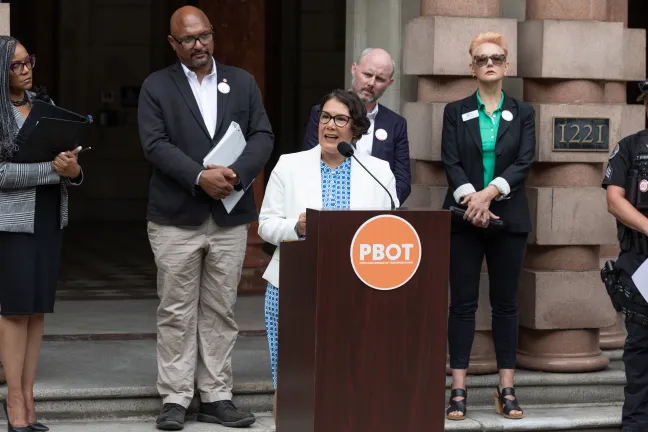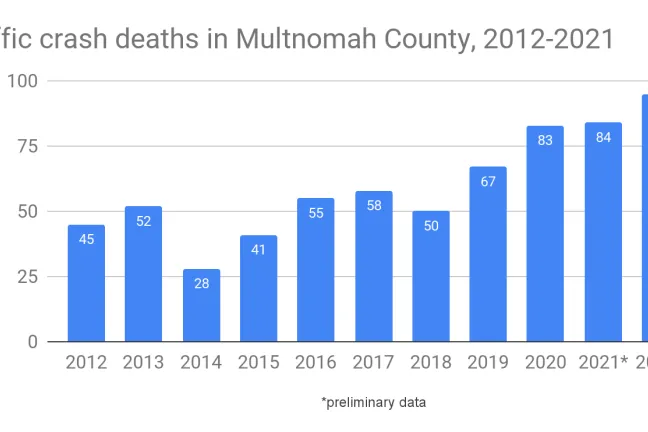Rates of traffic deaths are on the rise in the Portland metro region, mirroring a trend seen across the United States. The steepest rise in Multnomah County is in pedestrians who are struck by drivers. People over age 65, Black, Indigenous and other people of color (BIPOC), people with lower incomes, and people experiencing homelessness are disproportionately more likely to be killed or seriously injured in a pedestrian, bike or vehicle crash.
Those are some of the findings released today in a new, Multnomah County Public Health Division report that presents a summary of regional traffic fatality trends and their contributing factors assessed through a public health lens. Because all traffic-related deaths are preventable, the report chronicles trends - such as the increase in larger, heavier vehicles such as SUVs on the road - as well as recommendations to transportation planning agencies and decision-makers for more effectively preventing deaths by using improved design, operation and transportation policies to create a safer transportation system.
"This report hits close to home as Multnomah County tragically lost two employees to traffic crashes in the past six weeks. We grieve these losses, and insist on solutions that will prevent these senseless deaths in the future," Chair Jessica Vega Pederson said. "The work to address traffic fatalities and increase the safety of our streets has driven my work as an elected official since the beginning because this work is about making sure people and families can live and thrive in the places they call home."
According to Metro's 2019 report on traffic fatalities, traffic crashes are the leading cause of preventable injury and death in Multnomah County for people aged 5 to 24, and the second leading cause of unintentional injury and death for those aged 25 to 84. And the number of fatalities has only continued to rise.
Data from the Multnomah County Medical Examiner's Office shows that from 2015 to 2019, there was an average of 60 traffic fatalities per year in the county. However, from 2020 to 2021, there were a total of 170 traffic fatalities, resulting in an annual average of 85 traffic deaths - a 42% increase.
The report also found that people experiencing homelessness face disproportionate risk, accounting for 24% of all traffic deaths in 2020 and 2021. The higher rate and risk of traffic deaths among this population results from the combination of living in near-road environments and the higher level of exposure by virtue of being outside much of the time.
The data also revealed that substances like alcohol and other drugs were present in most deadly crashes, regardless of the mode of transportation, including pedestrians, bicyclists, motorcyclists and people in vehicles.
Toxicology tests indicated that 84% of pedestrians and 85 % people in vehicles who were killed tested positive for at least one substance. However, this does not necessarily indicate that people were intoxicated at the time of death, as some substances, like cannabinoids (marijuana), can be detected in the body long after their effects have ended.
Housing status and substance use need to be viewed as factors outside the control of transportation systems and infrastructure that contribute meaningfully to the risk of a traffic death. The Public Health Division recognizes that while traffic-calming street design can greatly contribute to a safe transportation system, we must continue to address contextual factors by working to provide housing and mental and behavioral health services.
The report recommends using a "safe system" approach to transportation system design that shifts the conversation around traffic fatalities away from individual responsibility and toward transportation policy choices and roadway design. The safe system approach lowers risk to drivers, pedestrians and cyclists through infrastructure and operational changes. These recommendations are intended to balance the County's limited role as a transportation agency with its more expansive role as the Local Public Health Authority.
"The traffic fatality report is a call to action to work collectively on adopting and implementing policy, system and environmental changes that will protect - and promote - the health and well-being of all county residents," said Brendon Haggerty, manager of the Healthy Homes and Communities program.
The report focuses its recommendations for improving traffic safety through six categories:
- Safe speeds
- Safe vehicles
- Safe road users
- Safe roads
- Optimizing the emergency medical services system
- Safe mobility for all modes of transportation
The Public Health Division relied on the help of the Multnomah County Public Health Advisory Board in the creation and review of the safe system recommendations. The Advisory Board is made up of 15 to 17 members from all over Multnomah County who advise in developing long-term approaches that address the leading causes of death and disability in the county.
The top recommendations that the Advisory Board support are adopting a safe speed policy; making investments in proven traffic-calming street designs; and advancing long-term system change by expanding automated enforcement such as traffic cameras and reforming fines and fees.
The report can be found
Related documents


